Sweet Corn
European corn borer (ECB) moth captures remain very low, and no map will appear in this addition. Feeding in late season pre-tassel corn in northern NJ continues, with some plantings exceeding the 12% threshold. In combination with fall armyworm (FAW) feeding, action thresholds have been exceeded in all areas of the state.
Growers should continue to scout whorl and pre-tassel stage plantings weekly and consider treating when infested plants exceed 12% in a 50 plant sample. As plantings proceed to the pre-tassel stage, ECB larvae may be found in emerging tassels. It is a good idea to treat individual plantings as they move into the full tassel/first silk stage one time. This eliminates any ECB larvae that have emerged with the tassels as they begin to move down the stalk to re-enter near developing ears.
Useful insecticides for this particular application include synthetic pyrethroids (IRAC Grp 3), spinosyns (including OMRI approved Entrust) IRAC Grp 5), and diamides such as Coragen (IRAC Grp 28) or materials such as Besiege which include the active ingredient in Coragen. Synthetic pyrethroids alone should NOT be used for corn earworm (CEW) protection on silking corn. Control with these materials is very inconsistent.
The highest nightly black light trap catches of ECB for the week ending 9/04/19 are as follows:
| Medford 2 | Jobstown 1 |
| Califon 1 | Jones Island 1 |
| Cinnaminson 1 |
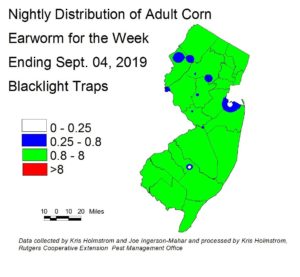 Corn earworm (CEW) moth catches increased in southern NJ this past week, while remaining stable in northern counties. Overall, CEW numbers now represent a sizeable late summer migratory influx. While moth counts will decline somewhat with cool night temperatures, look for strong rebounds when nighttime temperatures exceed 60F. The green area on the blacklight map (left) represents a 3-day silk spray schedule zone. Blue and white areas within the overall green zone are outliers, and corn growers in or near those areas should also adhere to 3-day silk spray schedules. There continue to be some exceptionally high catches in southern NJ pheromone traps this past week (see pheromone trap map below at right). Economically damaging populations of this pest are present throughout the state, and all areas are at extreme risk of crop injury if strict silk spray schedules are not observed. Red areas on the on the pheromone trap map indicate a 3-day silk
Corn earworm (CEW) moth catches increased in southern NJ this past week, while remaining stable in northern counties. Overall, CEW numbers now represent a sizeable late summer migratory influx. While moth counts will decline somewhat with cool night temperatures, look for strong rebounds when nighttime temperatures exceed 60F. The green area on the blacklight map (left) represents a 3-day silk spray schedule zone. Blue and white areas within the overall green zone are outliers, and corn growers in or near those areas should also adhere to 3-day silk spray schedules. There continue to be some exceptionally high catches in southern NJ pheromone traps this past week (see pheromone trap map below at right). Economically damaging populations of this pest are present throughout the state, and all areas are at extreme risk of crop injury if strict silk spray schedules are not observed. Red areas on the on the pheromone trap map indicate a 3-day silk 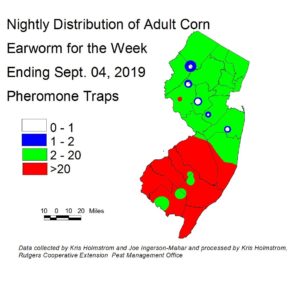 spray schedule, while green indicates a 4-5 day silk spray schedule. Currently, the black light network is indicating a more conservative spray regime statewide, than is the pheromone network. Taken together, blacklight and pheromone traps are indicating 3-day silk spray schedules throughout the state. There are far fewer CEW pheromone traps than blacklights, and the resulting map has much broader color bands as a result. It should also be noted that the pheromone traps are much more sensitive than blacklights. Therefore, the number of moths caught in pheromone traps required to generate a specific spray interval is much higher than the number caught in blacklight traps. It must be stressed that there is high variability in these catches, and growers should consult with their IPM practitioner on recommended spray schedules.
spray schedule, while green indicates a 4-5 day silk spray schedule. Currently, the black light network is indicating a more conservative spray regime statewide, than is the pheromone network. Taken together, blacklight and pheromone traps are indicating 3-day silk spray schedules throughout the state. There are far fewer CEW pheromone traps than blacklights, and the resulting map has much broader color bands as a result. It should also be noted that the pheromone traps are much more sensitive than blacklights. Therefore, the number of moths caught in pheromone traps required to generate a specific spray interval is much higher than the number caught in blacklight traps. It must be stressed that there is high variability in these catches, and growers should consult with their IPM practitioner on recommended spray schedules.
The highest nightly CEW pheromone trap catches for the week ending 9/04/19 are as follows:
| Woodstown 91 | Eldora 58 | Springdale 36 | Folsom 17 |
| Pedricktown 78 | Green Creek 56 | Beckett 31 | Elm 16 |
| Berlin 73 | Jobstown 42 | Monroeville 26 | Snyder Farm 16 |
Fall armyworm (FAW) feeding has remained somewhat low, but with threshold level infestations now found all over the state. Growers should scout all fields from pre-tassel stage down to early whorl stage. This pest causes extensive foliar damage on whorl stage corn (see photo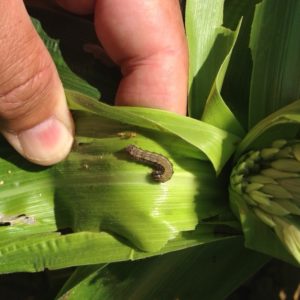 at left), can also infest ears, and is capable of killing small plants. FAW larvae are brown in color (see photo at right), with an inverted
at left), can also infest ears, and is capable of killing small plants. FAW larvae are brown in color (see photo at right), with an inverted 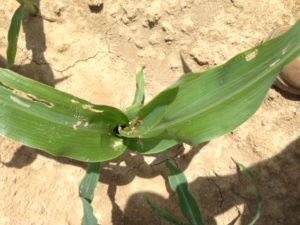 “Y” pattern on their head capsule. They are much larger than ECB when fully developed. FAW is even more consistently resistant to pyrethroid insecticides. For this reason, the same insecticides classes now recommended for CEW control should be utilized for FAW management.
“Y” pattern on their head capsule. They are much larger than ECB when fully developed. FAW is even more consistently resistant to pyrethroid insecticides. For this reason, the same insecticides classes now recommended for CEW control should be utilized for FAW management.
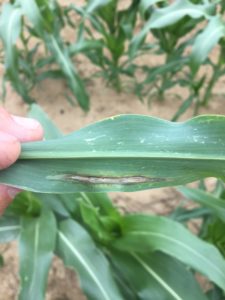 Northern corn leaf blight (NCLB) continues to increase in northern NJ sweet corn plantings, and may be present elsewhere. This disease causes elongated gray lesions, starting on older foliage (see photo at left). If uncontrolled, NCLB can result in enough foliage loss to limit ear size, as well as forming lesions on the husk leaves. Growers should be scouting for this disease when checking for insect injury. Control is necessary if lesions appear while plants are in the whorl stage. Heavier dew periods, common throughout September, favor disease development. Fungicides in FRAC groups 3, 7 and 11 are labled for control of this disease in rotation with chlorothalonil. See the 2019 Commercial Vegetable Production Guide for suggested materials.
Northern corn leaf blight (NCLB) continues to increase in northern NJ sweet corn plantings, and may be present elsewhere. This disease causes elongated gray lesions, starting on older foliage (see photo at left). If uncontrolled, NCLB can result in enough foliage loss to limit ear size, as well as forming lesions on the husk leaves. Growers should be scouting for this disease when checking for insect injury. Control is necessary if lesions appear while plants are in the whorl stage. Heavier dew periods, common throughout September, favor disease development. Fungicides in FRAC groups 3, 7 and 11 are labled for control of this disease in rotation with chlorothalonil. See the 2019 Commercial Vegetable Production Guide for suggested materials.
Corn leaf aphid populations continue to appear in pre-tassel stage sweet corn. 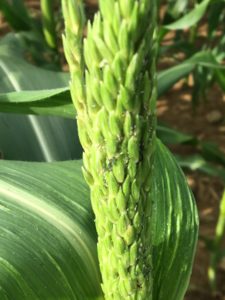 These aphids (photo at right) may be found in the emerged tassel while scouting for other insects. These insects are not controlled with IRAC group 5 or 28 insecticides, and pyrethroids are ineffective at killing aphids but very good at killing beneficial insects. Therefore, if corn leaf aphids are found in tassels, it is advisable to add the IRAC group 4a material Assail in with the first silk application for worm control.
These aphids (photo at right) may be found in the emerged tassel while scouting for other insects. These insects are not controlled with IRAC group 5 or 28 insecticides, and pyrethroids are ineffective at killing aphids but very good at killing beneficial insects. Therefore, if corn leaf aphids are found in tassels, it is advisable to add the IRAC group 4a material Assail in with the first silk application for worm control.
Silking Spray Schedules*:
South – 3 days
Central – 3 days
North – 3 days
*These recommendations are based on regional catches. Adhere to tighter spray schedules if indicated by local trap catches. To repeat: Synthetic pyrethroids alone should NOT be used for corn earworm (CEW) protection on silking corn, or for fall armyworm (FAW) management at any stage. Control with these materials is very inconsistent.
Peppers
Pepper weevil
Another farm has been found with a weevil infestation in Salem County. The lateness of the infestation means that there should be little crop loss, depending upon market prices and how long the farmer wants to keep
picking. It is difficult to see how the 2019 infestations have come to be, although as we have demonstrated in the past, there are many ways that weevils can be transported about the area. Traps in the Pedricktown and East Vineland area pepper fields continue to capture weevils.
As a reminder: Areas near food processing plants and land fills, especially those that accept vegetative waste are high risk areas for pepper plantings. Ideally, fields should be at least 1 mile from these facilities, or more. In these higher risk areas yellow sticky cards with pheromone lures should be deployed on the pepper field borders in the early growing season to help detect the presence of weevils.
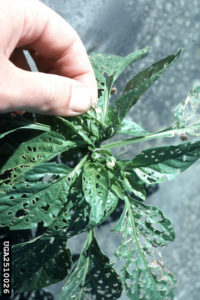 Pheromone traps established for beet armyworm (BAW) in the southern counties continue catching adults. This week’s average nightly catches include: Jones Island – 62, East Vineland – 37, Pedricktown – 8, Folsom – 3.
Pheromone traps established for beet armyworm (BAW) in the southern counties continue catching adults. This week’s average nightly catches include: Jones Island – 62, East Vineland – 37, Pedricktown – 8, Folsom – 3.
BAW can reach levels that result in damage to pepper plants, and injury has been reported in southwestern NJ. Growers in the southern counties should be alert for the appearance of severely defoliated terminals (see photo above at left) on pepper plants. Small BAW larvae (photo at right) feed on these leaves before turning to fruit as they increase in size. As with FAW, beet armyworm is resistant to pyrethroid insecticides. Insecticides now recommended for CEW and FAW control are useful for BAW management.
Tomatoes
With CEW numbers at high levels, tomato growers should be alert to the possibility of fruitworm injury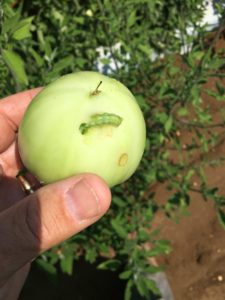 (see photo at right). CEW moths are attracted to blossom clusters in the upper canopy of plants. They lay eggs there, and larvae penetrate the nearest fruit without feeding on foliage. Thus, injury typically occurs on fruit in the upper and outer edges of the plant. With current CEW pheromone trap catch levels in south Jersey, it may be wise to treat preventively for this pest until numbers subside. If scouting, growers should consider an application to limit damage when the first sign of injury occurs. Insecticides in the IRAC group 28 (Coragen, etc.) and group 5 (Radiant, Entrust) are good choices, as they are effective against CEW and are less toxic to beneficial insects. The use of synthetic pyrethroids (IRAC 3) can increase aphid and mite populations.
(see photo at right). CEW moths are attracted to blossom clusters in the upper canopy of plants. They lay eggs there, and larvae penetrate the nearest fruit without feeding on foliage. Thus, injury typically occurs on fruit in the upper and outer edges of the plant. With current CEW pheromone trap catch levels in south Jersey, it may be wise to treat preventively for this pest until numbers subside. If scouting, growers should consider an application to limit damage when the first sign of injury occurs. Insecticides in the IRAC group 28 (Coragen, etc.) and group 5 (Radiant, Entrust) are good choices, as they are effective against CEW and are less toxic to beneficial insects. The use of synthetic pyrethroids (IRAC 3) can increase aphid and mite populations.
Pumpkins and Winter Squash
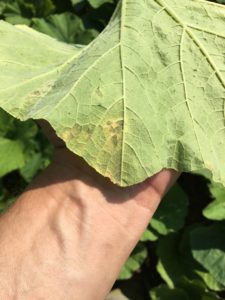 Cucurbit downy mildew (CDM) is active on cucumbers, pumpkins, acorn squash and butternut squash in NJ.
Cucurbit downy mildew (CDM) is active on cucumbers, pumpkins, acorn squash and butternut squash in NJ. 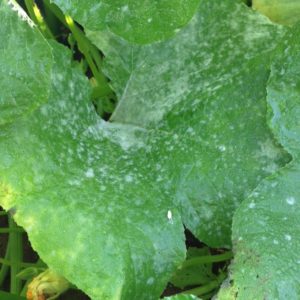 All growers should be applying appropriate fungicides for downy mildew on all cucurbit crops at this time. For regional information on this important disease, see the Cucurbit Downy Mildew Forecast webpage: http://cdm.ipmpipe.org/. Pumpkin and winter squash fields should also be managed for powdery mildew (see photo at right). Thresholds (2 lesions/50 older leaves) have been exceeded in all fields. See the Pumpkin and Winter Squash section of the 2019 Commercial Vegetable Production Guide for suggested powdery and downy mildew control materials.
All growers should be applying appropriate fungicides for downy mildew on all cucurbit crops at this time. For regional information on this important disease, see the Cucurbit Downy Mildew Forecast webpage: http://cdm.ipmpipe.org/. Pumpkin and winter squash fields should also be managed for powdery mildew (see photo at right). Thresholds (2 lesions/50 older leaves) have been exceeded in all fields. See the Pumpkin and Winter Squash section of the 2019 Commercial Vegetable Production Guide for suggested powdery and downy mildew control materials.
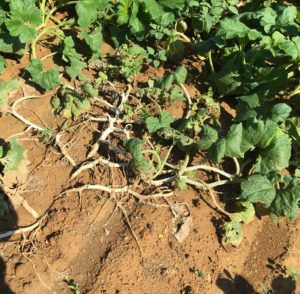 In addition, numerous instances of plectosporium blight have been discovered on pumpkin and winter squash fields recently. This disease is favored by wet soil conditions and may be confined to low spots in fields, or may infect many plants along the path water takes as it runs off after rains. The fungus Plectosporium causes numerous white, dry lesions on stems, petioles
In addition, numerous instances of plectosporium blight have been discovered on pumpkin and winter squash fields recently. This disease is favored by wet soil conditions and may be confined to low spots in fields, or may infect many plants along the path water takes as it runs off after rains. The fungus Plectosporium causes numerous white, dry lesions on stems, petioles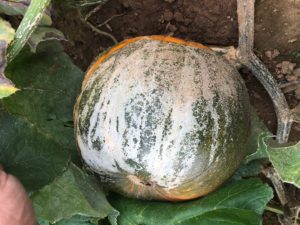 and fruit rinds (see photo at right). In severe cases, infected stems and petioles become brittle and the plant ceases growing (see photo at left). Growers are advised to include chlorothalonil in every spray, as this material is considered to be the most useful at limiting further infection. However, under the wet conditions we have experienced in recent years, this disease has proven difficult to control even with rigorous fungicide programs.
and fruit rinds (see photo at right). In severe cases, infected stems and petioles become brittle and the plant ceases growing (see photo at left). Growers are advised to include chlorothalonil in every spray, as this material is considered to be the most useful at limiting further infection. However, under the wet conditions we have experienced in recent years, this disease has proven difficult to control even with rigorous fungicide programs.
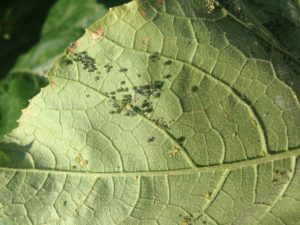 This is the time of the season when melon aphid (see photo at left) can appear in pumpkin fields. While this pest generally does not negatively impact yield this late in the season, large populations can cause cosmetic injury by depositing sticky droppings on developing fruit. A secondary fungus (sooty mold) grows on this substrate. Additionally, the sweet aphid droppings can attract hornets. This is a problem particularly in fields that are to be opened for U-pick customers. Recommended insecticides may be found in the 2019 Commercial Vegetable Production Guide, with several including Fulfill and Beleaf being much less toxic to bees. Consider treating if melon aphid colonies are found in more than one site in a ten site sample.
This is the time of the season when melon aphid (see photo at left) can appear in pumpkin fields. While this pest generally does not negatively impact yield this late in the season, large populations can cause cosmetic injury by depositing sticky droppings on developing fruit. A secondary fungus (sooty mold) grows on this substrate. Additionally, the sweet aphid droppings can attract hornets. This is a problem particularly in fields that are to be opened for U-pick customers. Recommended insecticides may be found in the 2019 Commercial Vegetable Production Guide, with several including Fulfill and Beleaf being much less toxic to bees. Consider treating if melon aphid colonies are found in more than one site in a ten site sample.
Brown Marmorated Stink Bug (BMSB)
BMSB numbers in blacklight traps remained low over the past week and no map will appear in this edition. Blacklight catches are likely a better indicator of stink bug activity (movement) than of actual numbers in a given area. Growers with crops that are potential targets of this pest should be scouting for BMSB or increases in stink bug injury.
The highest nightly catches of BMSB in black light traps for the week ending 9/04/19 are as follows:
| Centerton 2 | Folsom 1 | Woodstown 1 |
| Pedricktown 2 | Hillsborough 1 | |
| Downer 1 | Jones Island 1 | |
| East Vineland 1 | Monroeville 1 |

